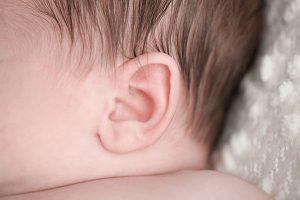Types of Hearing Loss
Conductive Hearing Loss
Conductive hearing loss occurs when sound cannot pass through the outer or middle ear into the inner ear. It can be caused by reversible conditions such as impacted wax, a punctured eardrum, fluid in the middle ear, or a middle ear infection. Conductive hearing loss can often be corrected through medical treatment or surgery. Without treatment, conductive hearing loss may become permanent.
Permanent Conductive Hearing Loss
Permanent conductive hearing loss occurs when sound cannot pass through the outer or middle ear into the inner ear due to conditions that cannot be corrected by medical treatment or surgery, or due to conditions that are expected to be of life-long or long-term duration. It can be caused by acquired conditions, such as middle ear scarring from ear infections or injury, and by congenital conditions, such as aural atresia or microtia.
Sensorineural Hearing Loss
Sensorineural hearing loss occurs when the auditory nerve or hair cells in the inner ear and/or auditory pathway are damaged. Causes may include noise, aging, infection, head trauma, ototoxic medications, or an inherited condition.
Mixed Hearing Loss
Mixed hearing loss occurs when both conductive and sensorineural hearing losses are present.
Auditory Neuropathy Spectrum Disorder (ANSD)
ANSD affects a small number of children with hearing loss. Although many appear to be NICU graduates, the exact prevalence of auditory neuropathy is unknown. This disorder is identifiable through OAE and ABR testing. This disorder is characterized by normal OAE results and absent or abnormal ABR results, suggesting functioning outer hair cells with abnormal neural conduction.
Other Classifications of Hearing Loss
- Unilateral vs. Bilateral Hearing Loss
Children with hearing loss in one ear should receive the same medical assessment to determine etiology as children with bilateral hearing loss, as well as audiology follow-up to monitor for progressive hearing loss and early intervention to support language acquisition. Some children with unilateral hearing loss may later develop bilateral hearing loss. Many will experience early language delays and may have difficulty understanding speech, depending upon the amount of background noise or their distance from the person speaking.
Degrees of Hearing Loss
Children without amplification who have mild hearing loss may be unable to hear as much as 50% of spoken language. Those with moderate hearing loss may be unable to hear as much as 90% of spoken language. Thus, any degree of hearing loss should be considered developmentally and educationally significant.
The Hawaii Department of Health utilizes the scale from the Centers for Disease Control and Prevention annual Early Hearing Detection and Intervention data report when describing degree of hearing loss:
| Degree | Responds at |
|---|---|
| Slight | 16-25 dB |
| Mild | 26-40 dB |
| Moderate | 41-55 dB |
| Moderately Severe | 56-70 dB |
| Severe | 71-90 dB |
| Profound | 91 or greater dB |
